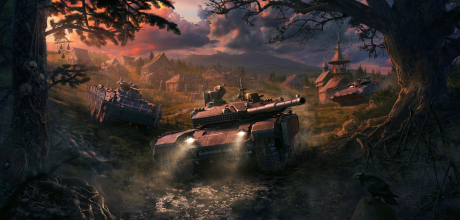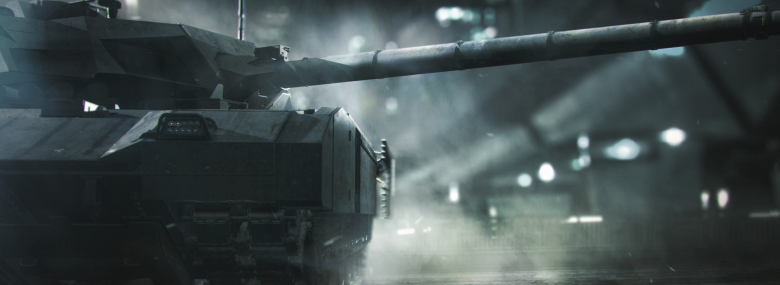
Commanders!
Yes, it’s that time already. Today we’d like to tell you more about the first prize of the upcoming Tales from the Dark Battle Path. The first machine obtainable will be the BTR-82A Armored Fighting Vehicle.
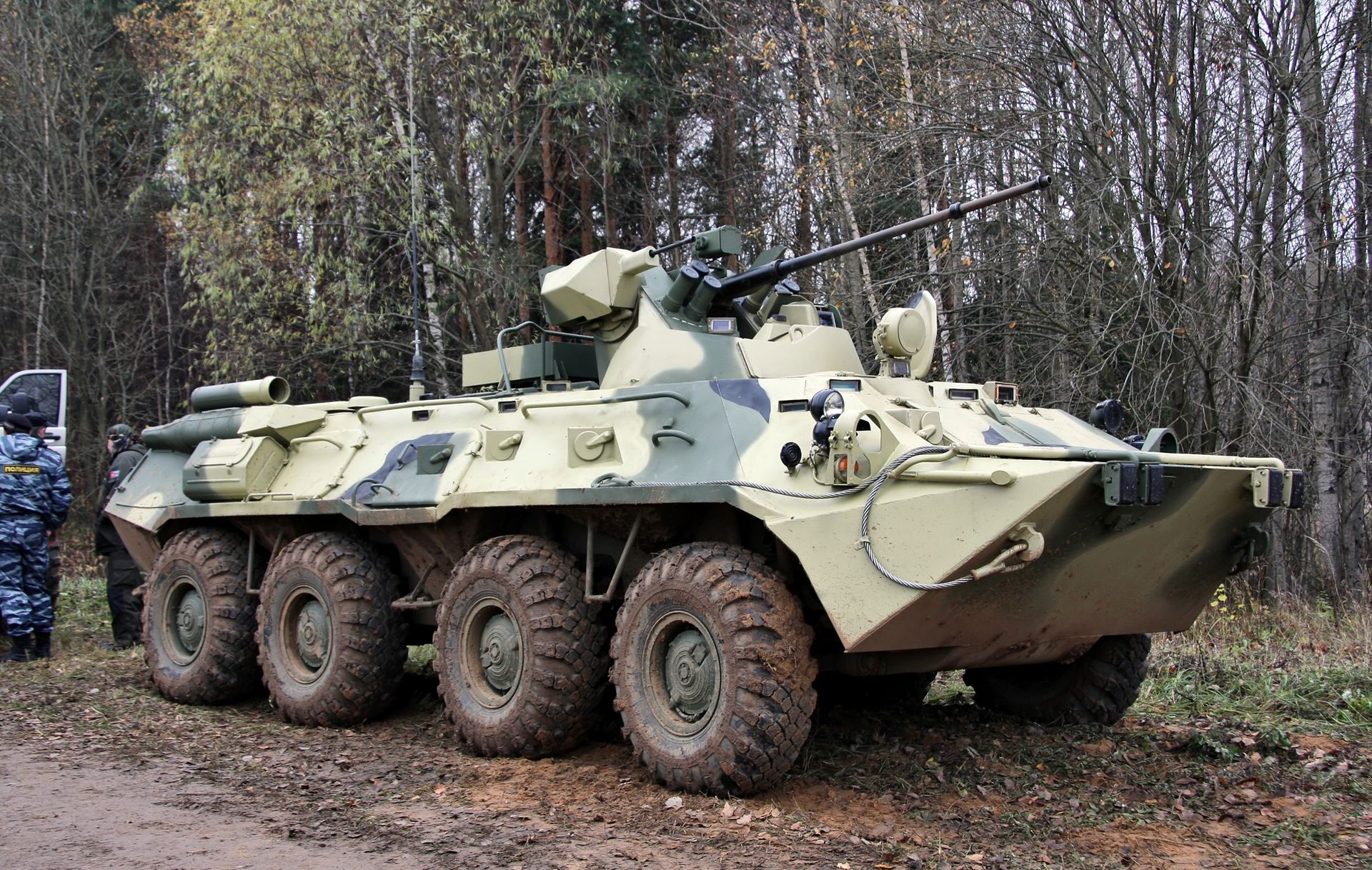
BTR-82A
The BTR-82A is a modified version of the BTR-80, which itself is an evolution of BTR-70 so it makes sense to start in the past. In fact, let’s go all the way back to the 1950s. Back then, the Soviet Army was equipped with an armored six-wheeled variant of the ZIS-151 truck called BTR-152. BTR stands simply for “bronetransporter”, commonly translated as “armored personnel carrier” or simply “APC.” It had a lot of weaknesses, the chief amongst them being the inability to keep up with tanks and other tracked vehicles in difficult terrain, especially when crossing trenches and other obstacles. Despite this, it was a successful vehicle produced between 1950 well into the 1960s that was widely exported and license-built in China.

BTR-152
But the Soviet Army demanded more – a troop carrier of excellent off-road capabilities and none of the issues the BTR-152 had. And that’s how the BTR-60 was born. The BTR-60 model had sloped frontal armor for improved protection and excellent mobility thanks to its eight wheels. It wasn’t exactly well-protected on the sides (anti-bullet armor, steel only) but that wasn’t really a requirement. The important part was the fact it could finally keep up with armored formations and could, like the BMP-1, swim. It entered Soviet service in 1960 under the name BTR-60P (P stands for “plavayushiy” – “amphibious”) and would be produced in several modifications (the most successful being the BTR-60PB) for another nearly three decades until 1987 with over 10.000 built (but western sources claim as many as 25.000).

BTR-60PBK
An upgrade of the BTR-60PB called BTR-70 was developed in 1969 with some differences that aren’t really all that obvious to an untrained eye – mostly a longer hull and more powerful engines (the BTR-60PB had two 90hp engines and the BTR-70 had two 120hp engines). It was accepted in service in 1971 and produced from 1976 well into the 1980s with, once again, several thousand vehicles built and exported.

BTR-70
Enter the 1980s and the Afghan War. The wartime experience gave birth to another upgrade in the lines of eight-wheeled BTRs, called BTR-80. The BTR-70 suffered from a number of issues, including reliability problems of its two carbureted engines, poor protection and the general layout of the design. The BTR-80 solved some of these with the engines being replaced by a single 260hp diesel. The exit door was also redesigned and was located on the side of the vehicle.
To accommodate that as well as other changes, the BTR-80 was longer, wider and heavier than its predecessor, but not by a lot (the weight increased by 2 tons to 13.5 tons). The drawback was that the protection was increased only slightly and still consisted of welded steel plates that could only stop small arms (the sloped front was 10mm thick, the sides were 7mm to 9mm thick).

BTR-80
Despite the weight increase and the engine change, the mobility remained roughly the same (the operational range actually increased). The vehicle was still pretty fast and could reach the speed of 80 km/h (40 km/h off-road). It could also swim (the maximum swimming speed was 9 km/h). The armament consisted of a machinegun in a small turret (like its predecessors) and that was about it.
This APC entered service in 1986 and remained in production well beyond the fall of the Soviet Union with roughly 4000 built. Former Soviet republics inherited their share of the BTR-80 and the vehicle was also exported to several dozen countries. Numerous upgrades were also developed and produced, including the BTR-80A APC from 1994 that was armed with 30mm autocannon in a new turret, significantly increasing its firepower. Even today, the BTR-80 remains quite a common sight despite the concept being somewhat obsolete.

BTR-80A
The obsolescence stems from the fact that the world has simply moved on from large masses of cheaper APC vehicles to more expensive but less numerous infantry fighting vehicles – at least in frontline service. The reasons are simple – few countries have manpower to spare and as modern weapons require more and more specialized and better trained troops, the life of each individual soldier has become a precious commodity.
The BTR-80 production stopped in 2011 and especially Russia was left with hundreds (if not thousands) of these in its stocks as well as the tooling to produce even more. Additionally, there was the experience from the 1990s and 2000s wars to consider (mostly Chechnya).
To use all that potential and mould it into something new, a large upgrade of both the BTR-80 and BTR-80A variants was developed by AMZ (Arzamas Machine-Building Plant) between 2009 and 2011 with the first prototypes being ready in 2009 and tested extensively in 2010. These upgrades proved to be so comprehensive that each vehicle received a new designation:
- The BTR-80 upgrade (machinegun version) received the designation BTR-82
- The BTR-80A upgrade (version with 30mm autocannon) received the designation BTR-82A
The main goals of the upgrade were stated to be a general upgrade of most characteristics as well as reliability and, upon its reveal, it was stated that the upgraded vehicles had 2 times higher combat value than their earlier BTR-80 counterparts while retaining the crew of 2 men and the ability to carry 8 more in the back.

BTR-82A
The biggest upgrade was the firepower. The BTR-82A was equipped with a new unmanned turret with a stabilized gun mount housing the 30mm 2A72 autocannon along with a coaxial 7.62mm PKT machinegun. The turret was designed so that it could carry other types of armament as well (like foreign alternatives to the main armament for export). During the development, the 14.5mm KPVT machinegun variant was dropped entirely.
The gunner had a new stabilized TKN-4GA sight at his disposal. It wasn’t all roses and sunshine as the initial accuracy when firing on the move was quite low (due to the inherent instability of the wheeled platform compared to a tracked one). These issues were, however, solved to the point where the BTR-82A was about as accurate on the move as a BMP-2.
While the armor remained fairly thin (basically anti-bullet only), the crew protection was increased by including a new aramid spall liner. The bottom was also redesigned and included spaced plates in order to increase the protection from mines. The vehicle retained the side hatches, making it faster for the troops to disembark and to use whichever hatch was more convenient (or at least that was the theory).
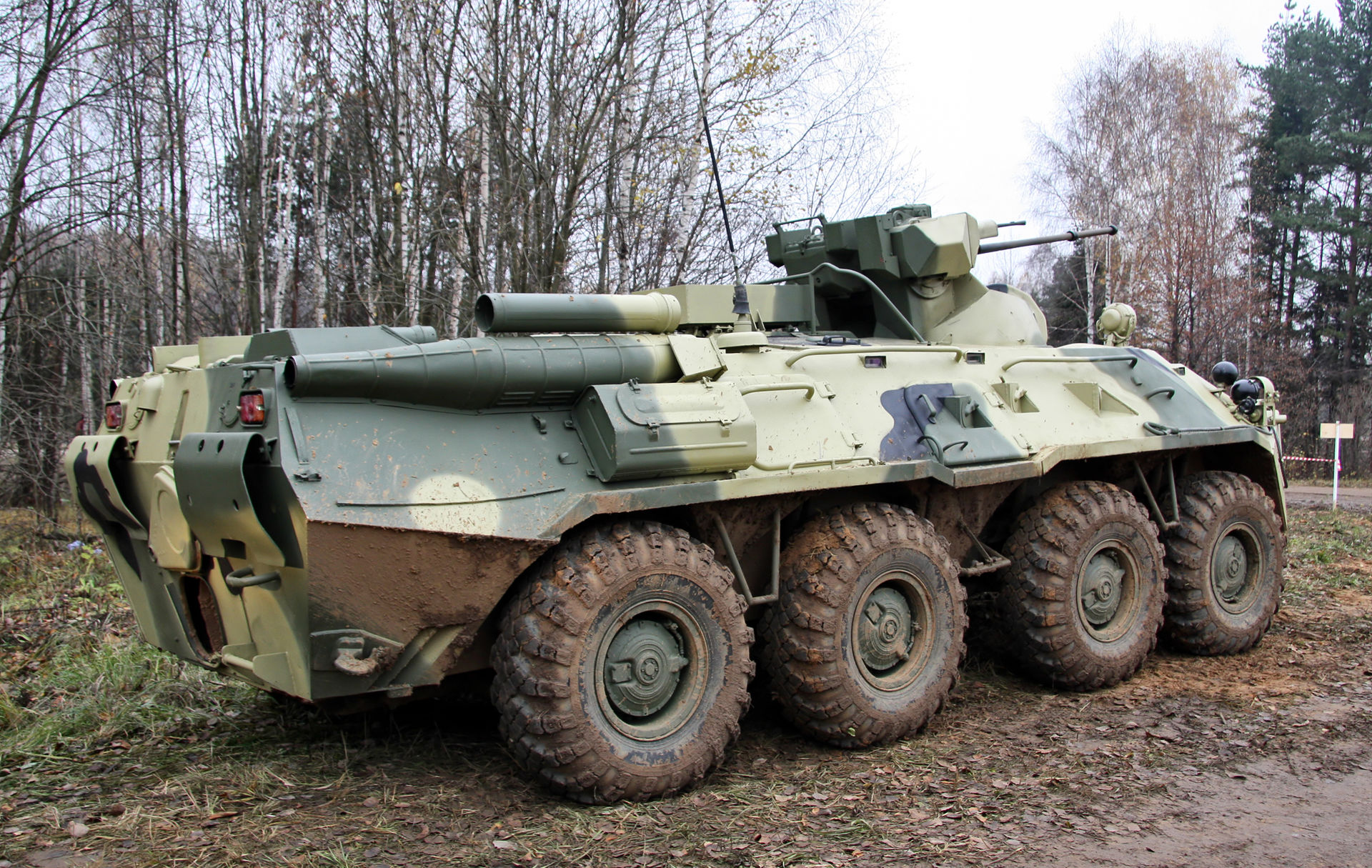
BTR-82A
These changes of course increased the vehicle’s weight (to 16 tons), which was compensated by the installation of a more powerful engine (KamAZ-740.14-300 diesel producing 300hp) along with transmission and suspension improvements. The BTR-82A also remained amphibious. There were other improvements in electronics as well and an air conditioner was installed to increase the crew’s comfort.
The vehicle officially entered Russian service in December 2012 and was first shown to the public during the 2013 Victory Day military parade in Moscow. At that moment it was already two years in production (since 2011). It’s worth noting that these were all newly built vehicles – older BTR-80s were also converted to the BTR-82 standard (but these refitted vehicles became designated BTR-82AM). The conversions weren’t much cheaper though – due to the extent of the overhaul, the cost of such a vehicle was only roughly 15% lower than that of a new one.
The production of the BTR-82 is running to this day with the estimates varying between 1500 vehicles built to more than 2000 (how many of these are newly built or conversions is unclear). At the moment it is only covering the needs of the Russian Army, although in the past the vehicle seems to have been exported in some numbers, most notably to Kazakhstan. It was also seen in Syria during the Russian intervention (and some of these were allegedly transferred to Syrian hands).

BTR-82A in Kazakhstan
Interestingly enough, sources vary wildly when it comes to foreign sales of the BTR:
- Azerbaijan is supposed to have 100 to 200 according to some (from 2018-2023) and used them during the Nagorny Karabakh war in 2020 (which seems plausible as one of these was captured by the Armenians)
- Belarus is supposed to have around 30
- Uzbekistan and Kyrgyzstan are supposed to have anywhere between 20 and 110
The BTR-82A has seen several conflicts since its introduction. As was mentioned above, it was used in Syria in 2015, in 2020 during the Armenia-Azerbaijan war and, most notably, during the Ukraine conflict where a number of them were captured by the Ukrainians.

BTR-82A with cage armor
Several upgrades were developed for the vehicle over the years, including a spaced armor kit, a slat armor kit on top of that and two Kornet launchers added to the turret.

Turret with two Kornet launchers
But even in its basic state, it’s a solid machine that’s performing well on the battlefield – or, rather, as well as can be expected with the changes the use of drones en masse has brought.
In Armored Warfare, the BTR-82A will be a Tier 8 Premium Armored Fighting Vehicle.
What you’re looking at is a lot of firepower in a relatively fragile package. At first glance it’s obvious that the BTR-82A is not well-armored and even though an armor kit will be available as a Battle Path overprogression module, the armor will be nowhere near as thick as on other modern IFVs.
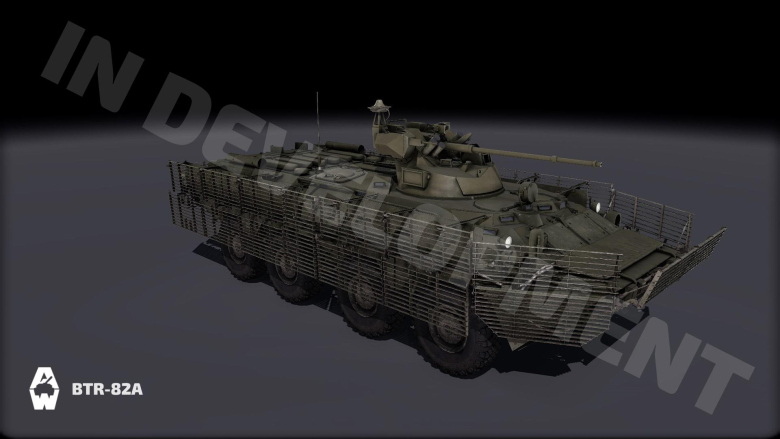
Click the image to open a larger version
However, the vehicle’s other traits more than make up for this handicap. The BTR-82A will not only be highly mobile thanks to its low weight and powerful engine. We’re thinking:
- 3.8s to 32 km/h
- 21.41s to its maximum speed of 80 km/h
- Hull traverse rate 47 deg/s
But, most importantly, the BTR-82A will essentially feature Tier 10 firepower as its autocannon is similar to that used by the T-15 with the same shells, accuracy and all that. We will naturally tune down the damage output so that it doesn’t dominate everything on its Tier but its firepower will still be very high. And that’s without the second overprogression update that will add two twin-tube Kornet launchers to the vehicle (again, similar to the T-15 Armata) – and yes, they will come with the double launch feature.
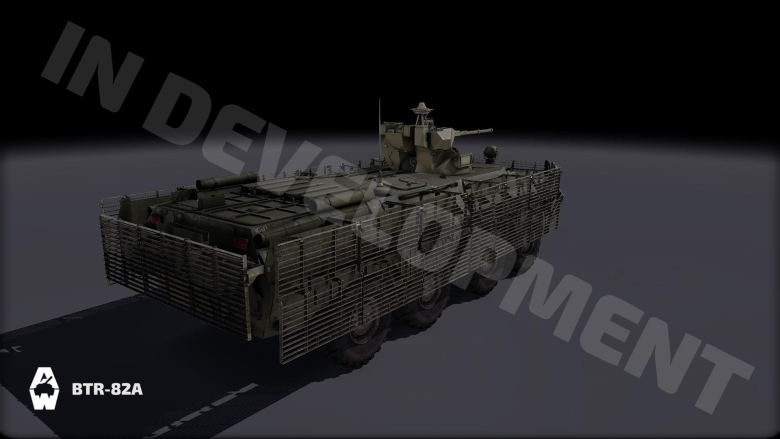
Click the image to open a larger version
For the future, the vehicle will also receive a new ability called Drone Jamming that will, as its name suggest, counter drones (the visual model will have the Volnorez jammer on it).
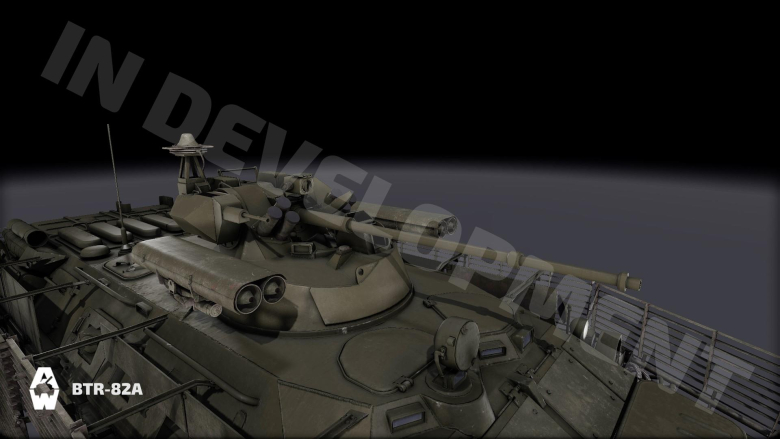
Click the image to open a larger version
In summation, the BTR-82A will be a glass cannon IFV with thin armor but a lot of firepower – a great tool for either risky PvP gameplay or overall great PvE performance.
We hope that you’ll like it and, as always:
See you on the battlefield!





